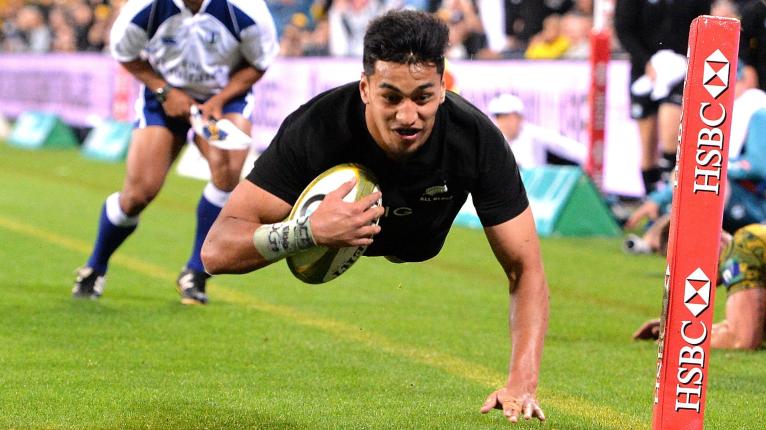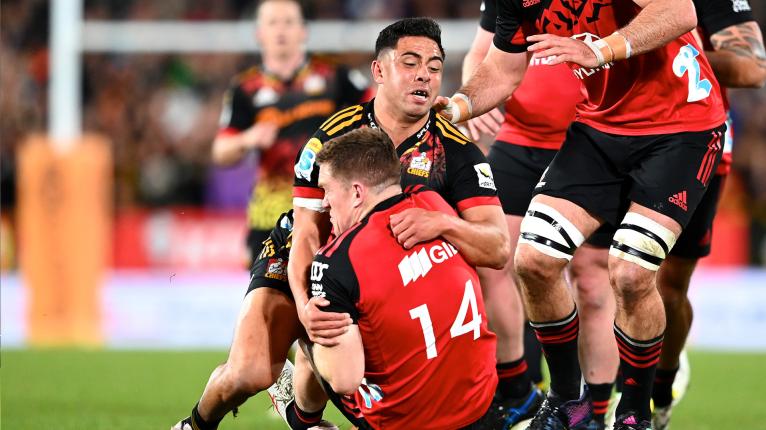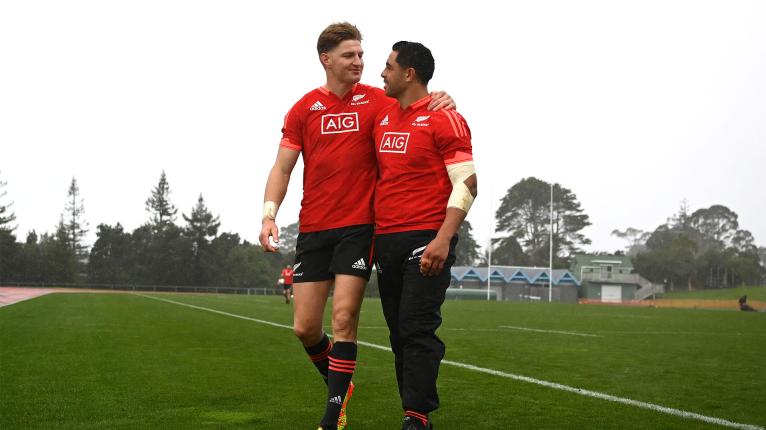Despite having spent the better part of four seasons playing almost exclusively in the No 13 jersey, it’s fair to say that some reservations remain about Rieko Ioane’s ongoing selection in the midfield for the All Blacks.
Those reservations have perhaps amplified in the wake of an incredibly tidy performance by Anton Lienert-Brown in the final pool game of New Zealand’s Rugby World Cup campaign.
26-year-old Ioane spent the vast majority of his schoolboy rugby at centre, helping Auckland Grammar to a top four finish in the 2014 NZ national competition. Like many young midfielders, however – particularly those with pace to burn – Ioane was ushered onto the wing when he started his professional career.
The likes of George Moala and Vince Aso were preferred in the centres for Auckland while the Blues had Moala, Rene Ranger, Male Sa’u and Piers Francis on their books – not necessarily all household names, but ostensibly safer bets in the middle of the park compared to the young and inexperienced Ioane.
Ioane’s shift to the wing wasn’t a failed experiment by any stretch of the imagination. For a few years, the youngster was one of the most lethal finishers in world rugby, scoring 22 tries in his first 21 appearances for the All Blacks.

With the World Cup on the horizon in 2019, however, the rich vein of form dried up and Ioane eventually lost his place in the All Blacks starting line-up to George Bridge.
Following New Zealand’s third-place finish at the 2019 showpiece event, Ioane’s time on the wing came to an end and he began an all but permanent transition back into an outside centre – a role he’d not filled except in dribs and drabs since those storied schoolboy days.
Like Ioane’s move from centre to wing, the more recent positional swap has certainly not been a failure.
Ioane’s pace in the midfield is a massive asset, whichever team he’s representing. On attack, he has the ability to punch onto passes and exploit even the smallest gaps in defensive lines. You only have to look to the most recent clash between NZ and France where Ioane burst onto a short ball from Anton Lienert-Brown and raced down the field to give the All Blacks the territory and front-foot ball they needed to eventually score the opening try of the match.
On the other side of the ball, Ioane’s speed makes him one of the best cover defenders in the New Zealand set-up.
Knowing when to run, when to pass, when to offload and when to simply take contact is a difficult but critical skill for midfielders to master.
But for those obvious strengths, there remain concerns that Ioane at times still operates like a winger playing in the centres.
Gaps are more prevalent in the All Blacks defensive line with Ioane wearing the No 13 jersey and the 26-year-old’s decision making with the ball has also let him down on more occasions than the coaches would be content. That was most evident in the team’s recent annihilation of Italy. Who would have thought that in a game against one of the most porous defences shown by a side at the World Cup, Ioane would fail to flourish?
Knowing when to run, when to pass, when to offload and when to simply take contact is a difficult but critical skill for midfielders to master – and it has proven especially so for Ioane, who thrived on the wing when there were fewer options to consider and when putting the foot down was very typically the best solution to any problem.
All of which isn’t to say that Ioane is not a good centre – he’s just not in the same echelon as world-class players like Lukhanyo Am and Garry Ringrose, and the jury is out on whether he could hit those same heights.
The most natural outside centre the All Blacks currently have at their disposal is Anton Lienert-Brown, a man who barely put a foot wrong against Uruguay on Thursday night. Obviously putting in a great performance against a tier-two side is not a strong indication of whether a player will thrive in more challenging contests, such as New Zealand’s upcoming quarter-final tussle – likely to be played against Ireland in Paris next weekend. Lienert-Brown, however, is an experienced campaigner with 67 caps to his name and has very much looked the goods for NZ in the past.

What’s held the 28-year-old back in recent times has been a steady run of injuries which has prevented the senior midfielder from stringing together successive matches and building form.
A string of unrelated injuries meant Lienert-Brown missed half the 2021 campaign, including the end-of-year tour, while a shoulder injury the following season saw Lienert-Brown sidelined for six months, only returning for the All Blacks’ northern tour where he earned one start against Scotland. This year, an ankle sprain invalided him for much of the Super Rugby season while a high tackle on Dallas McLeod in the Super Rugby Pacific final kept him out of the international arena for a further two weeks.
In fact, since the beginning of the 2021 season Lienert-Brown has mustered just 11 starts for the All Blacks, but only twice during that period has he featured in back-to-back Tests, and only once in back-t0-back Tests in the same position.
The other major factor that’s played into Ioane’s favour and really prevented any other challengers from contesting the starting centre role has been the selectors’ decisions to typically field their top centres combination, or an entirely different midfield with the two first-choice players, Ioane and Jordie Barrett, given the week off. The opening match of the 2023 Rugby World Cup was the first time since Barrett was shifted into the midfield last September that Ioane wore the No 13 jersey without Barrett alongside him.
Not once, until this week’s clash with Uruguay, had Lienert-Brown been given the opportunity of partnering Barrett, a man who has added some much needed size and power at inside centre for the men in black.
When you think of the attributes of a 12, he’s got them all.
Anton Lienert-Brown on Jordie Barrett
Instead, Lienert-Brown typically found himself running out alongside David Havili, a man who was ostensibly asked to do exactly the same role as Barrett but, at least from a physical point of view, is entirely incomparable to the 106-kilogram, 1.96-metre behemoth. Havili has never been capable of creating space for the men around him in the international arena due to his lack of size, especially in conjunction with the game plan employed by Foster and co. With Havili at 12, it’s hard to say that any outside centres have flourished. Barrett has changed things, however, and Ioane has been the primary beneficiary.
“When you think of the attributes of a 12, he’s got them all,” Lienert-Brown said of Barrett after the All Blacks’ final pool game on Thursday. “He’s big, he’s physical. But he’s got the skill set of a fullback as well.
“He brings that physical presence and he draws players in.”
With Barrett as his partner in New Zealand’s 73-0 thrashing of Uruguay, Lienert-Brown didn’t put a foot wrong. He made some great runs in the midfield, looked for safe but damaging offloads, and knew exactly when to deliver the pass to his outside mine. Barrett’s inclusion at 12 gave the 28-year-old room to move and he took full advantage of the extra space while never overplaying his hand.
“We actually had a conversation during the week and he mentioned that it was the first time I was playing inside him and I had to remind him that I’d played plenty outside him in Tests too,” Barrett said of his midfield partner. “It’s great playing alongside Anton. I’d be disrespecting him if I said he just does the basics well and the fundamentals well because he’s got so much more to his game. He’s got a great voice and a great skill set so he’s great to work with.”

With two very dangerous, in-form wingers in Mark Telea and Will Jordan, Foster won’t necessarily be looking for his midfield to make breaks but rather to create them. If the former were the goal, then it would be impossible to look past the deadly speed of Rieko Ioane, but given the latter is likely, it could be that a last-minute change is on the cards for the All Blacks line-up ahead of their do-or-die quarter-final.
It might look like a chaotic move from Foster on the eve of what could be his final match in charge of the All Blacks, but Lienert-Brown is a supremely experienced operator and – as mentioned by Barrett – while the 12-13 combination would be relatively fresh, the pairing have worked together in plenty of Tests in the past.
Rieko Ioane was exploited on defence the last time the All Blacks faced off with Ireland and Andy Farrell’s men would no doubt look to do the same next weekend but a change to New Zealand’s starting line-up could add exactly the kind of spice needed to help them get one up over their rivals in the north. It would be a bold decision from Ian Foster – but not one without merit.



yep rieko is the man to confuse if i were looking for the weakest link tom i think you are unfortunately spot on the way he got stood up mmmm all that speed
We have backs good enough to win this World Cup. Our front row and loosies not good enough so far since Dunedin against Australia. Looking back it shows you how weak they were against the Aussies. What game plan do we use to beat Ireland in quarter finals? I can't think of one. Be great if our Loosies had the "Heart of Roiguard and Faianga'nuku and their vision"
I noticed that too actually. While Faianga’anuku looked impressive as a ball carrier and try scorer, I hope they don’t drop Lienert-Brown to make way for him. He would actually be my first choice centre, truth be told, but he is too good - defensively - to miss out of the 23 man squad altogether.
Definitely a tough call, personally ALB for me has come back and done everything right as a quality defensive player with the ability to coordinate his outsides. I'd pick him to start at centre along with Leicester starting on the left with Telea on the right and Beauden at Fullback. Bench would be Roigard, Rieko and Jordan, not buying the McKenzie hype. Very disappointed in NZ's loose forwards who've been flat and disappointing so would start Dalton, Frizzell and Savea with Ethan on the bench along with Whitelock.
To be fair, Reiko’s defence has improved over the last year or so. I wonder if ALB is physically prepared enough for a big test against a physical opponent with his recent injuries, he doesn’t look in peak shape right now. Maybe the AB’s are better off with Fainga’anuku on the bench instead of ALB. In that final game in ‘15 SLB came on for Conrad Smith to add some muscle in the back line. Handy having some omph off the bench is kinda handy in do-or-die match.
The problem with Ioane is that his best attributes are his electric pace and finishing skills. He is one of the best players in the World when put into space, little argument about that. At centre he seems a little wasted in that regard, he doesn't see much ball against the top defences and a lot will tend to be in contact. He's not a natural power player like Fainga'anuku or a link man like ALB. Can't help but feel he had so much more to give on the wing. And can't help but wonder why we are always converting players into centres. Ireland seem to be doing pretty well with one of our overlooked specialists.
Individual defensive errors are far more likely to cost the ABs the game vs Ireland than individual brilliance in the midfield is to win it.
If the ABs are going to win this game whoever plays 13 will have to put in a huge shift defensively, and it could be a deciding factor in the outcome. SA picked two tackling machines in Kriel and De Allende which nullified the Aki/Ringrose threat to some degree, but neither of those two are ball players so their lethal back are relegated to kick chasers.
As the article points out with Jordan, Telea, Liecester, DMac, and BB to choose from in the back 3 it's far more important our 13 can 1) defend very well and 2) link up with those x factor players at the right time in the right place.
It's harsh on Reiko because he is a great player, but he was exposed defensively so many times by Sexton, Aki, Ringrose, and Keenan last year. Even vs. Italy last week he found himself in no man's land and M.Ioane did him easily and set up a try. Ireland will attack that all day long.
ALB starts for me for those reasons, and a straight shoot out between LF and Reiko for a bench spot alongside DMac. Reiko would be the safer bet - an early injury to ALB (which is likely given his history) would see LF covering 13 which would be even more problematic defensively than Reiko, as he is even less experienced there at top level.
Robbie Henshaw is out of Irelands possible Quarter Final good news for Ioane - its to late now to change him - the selectors have to put him there or its back on the wing - they cant just drop him. Hes a terrific player his speed in covering defense is helpful but its no good if he cant tackle - he will need to get that bang on against Ireland and you can bet hes on the tackle bags as we post - if he was to go down injured ALB would step in although I consider him a better 12 than 13 however he is running into some good form
As mentioned, Ioane's defense gives too much space and Ireland will feast. But Foster will not change so a mute point
Like many young pacifika player... he probably had physical advantages growing up in school rugby, and as is the school way, not as many close battles as you do growing through club and provincial rugby, so defence is something you have to learn at the next level up, but he skipped that too becoming a star winger.I have to thank Reiko, and his brother, for re-signing with NZR. We get to watch his talents for another few years at least.
I thought Goodhue showed enough in his return that he could handle the dynamics of both sides of the game better, and that would allow the AB's to play Reiko one last year where he is the best threat. ALB is still a 2nd five for me, not direct enough a whole runner then passer, for center.
I don't think anyone can fix the frailties that exist at this stage, he will continue to be a center and the worlds best by the time the next WC comes around.